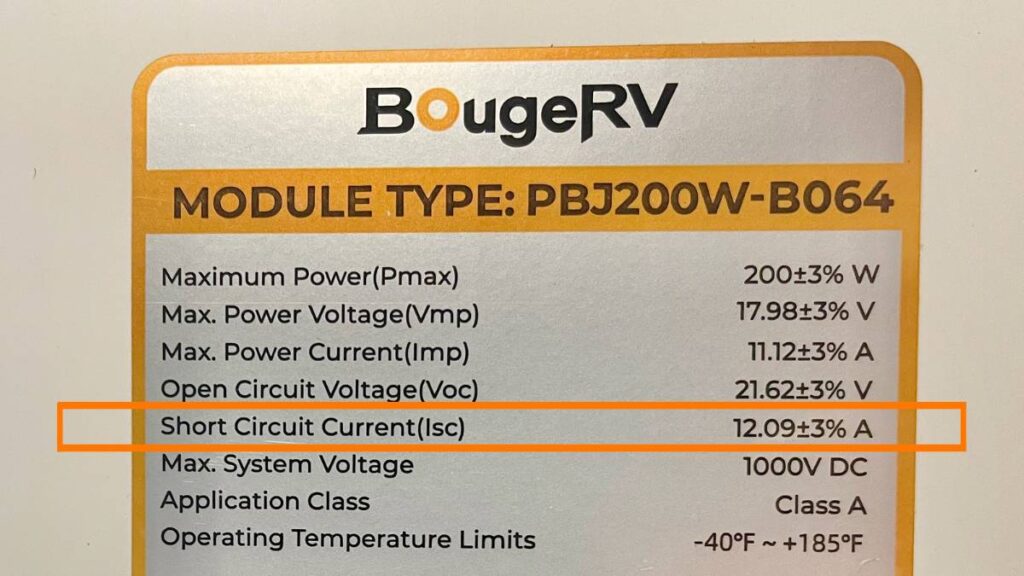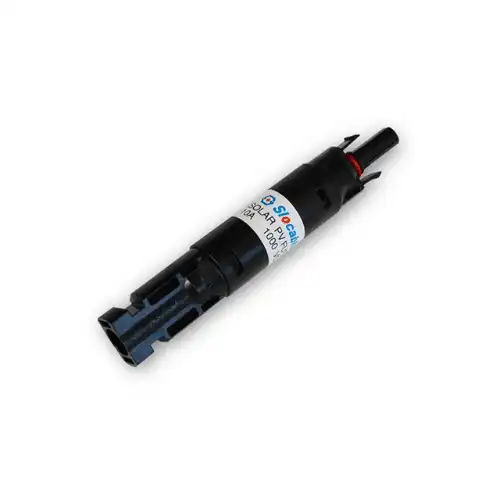You typically do not need to fuse solar panels if you wire them in series, because the amperage of a short circuit will not exceed what your solar panel or wiring can handle.
But if you employ parallel wiring, your solar array will likely require fuses because the total amperage in a short circuit may be high enough to cause problems.
To understand when and how to fuse solar panels in your off-grid camper van electrical system, we need to take a closer look at what happens to Amps and Volts in each wiring configuration.
This post is adapted from our ebook Vanlife Solar Basics.
Are you tired of jumping from website to website trying to wrap your head around your van’s electrical system? Our comprehensive guide covers everything from fundamentals to components to sizing to installation, all in one easy-to-follow package.
The Purpose of Solar Panel Fuses
Solar fuses are important safety devices that prevent excess electrical current from overloading the wires and components in a photovoltaic (PV) system.
Fuses provide this overcurrent protection by “blowing” and cutting off the flow of electricity whenever the current exceeds the rated amperage of the fuse. Without proper fusing, too much current can cause your wiring or solar panels to overheat and catch on fire.
Electrical fires are bad news all around, especially when they occur on the roof of a small mobile dwelling like a DIY camper van or RV. Luckily, it’s easy to prevent this from happening by properly fusing your solar panels with inline MC4 fuses matched to the maximum series fuse rating of your solar panels.
Use this to safely fuse your solar panels.
Enter discount code Gnomad8 for 8% off at Renogy.com
So why wouldn’t you just install solar panel fuses no matter what? Because in some use cases, adding a solar panel fuse is completely unnecessary.
When Fusing Solar Panels is Required
Per the National Electric Code, you need to fuse solar panels when the total current that your solar panel array can produce during a short circuit is greater than the maximum series fuse rating of your solar panels.
Before we dig into what this means, we first need to understand what happens to the electrical current when you wire solar panels in series vs parallel.
- With series wiring, the voltages of your solar panels add together, while the current (amperage) stays the same.
- Example: Four 100W panels that produce 5A at 20V wired in series will output a total of 5A at 80V (20V x 4 panels = 80V).
- With parallel wiring, the current of your solar panels adds together, while the voltage stays the same.
- Example: Four 100W panels that produce 5A at 20V wired in parallel will output a total of 20A at 20V (5A x 4 panels = 20A).
It’s important to emphasize that parallel wiring is the only configuration that increases the current output of your solar panels (along with the hybrid configuration series-parallel).
This increase in current is why parallel wiring typically requires solar fuses, whereas series wiring typically does not.
Read More: Wiring Solar Panels in Series vs Parallel
Why You Need to Fuse Solar Panels Wired in Parallel
To understand why you need to fuse solar panels wired in parallel, we need to look at a couple of solar panel specs: short circuit current (Isc) and maximum series fuse rating.
- Short circuit current (Isc) is the maximum current that your solar panel will produce in the event of a short circuit.
- Maximum series fuse rating is the maximum amount of current that your solar panel is designed to withstand without issue. Meaning, this is the largest fuse size you should use with your solar panel.
You should be able to find these numbers either on the back of your solar panels or in the manual/spec sheet.
Let’s look at an example using three 200W BougeRV 9BB solar panels wired in parallel.
The label on the back of the panels only tells us the short circuit current (12.09A), and we had to dig into the manual to find the maximum series fuse rating (15A).

Remember that with parallel wiring the amperage increases, so the total short circuit current of this solar array is 36.27 Amps (12.09A x 3 panels = 36.27A).
In the event of a fault or short circuit in one of the panels, the other two panels would dump 24.18 Amps of current into the faulty panel (12.09A x 2 panels = 24.18A). Add in the 12.09A from the shorted panel itself and there could potentially by 36.27A of current flowing through it.

This is significantly higher than the 15 Amps these solar panels are designed to handle, which could cause overheating and a fire.
Because the total short circuit current (36.27A) is greater than the maximum series fuse rating (15A), a fuse is required where the solar panels combine.
This means placing 15 Amp fuses at the point where each parallel solar panel (or panel string) enters the parallel wiring connector (or combiner box).

If this parallel solar array is properly fused, 24.18 Amps flowing into the faulty panel would blow the 15 Amp fuse, stopping this dangerous overcurrent situation before it starts.
Why You Don’t Need to Fuse Solar Panels Wired in Series
When solar panels are wired in series, the amperage does not increase. This means that the short circuit current number of a single panel is the maximum amount of current that will be produced by the entire array during a short circuit.
As long as the total short circuit current is below the maximum series fuse rating (which it is in a series string), then there is no danger of overheating or fire in the event of an electrical fault, and a fuse is not needed.
Let’s again look at an example using three 200W BougeRV 9BB solar panels, this time wired in series.
In the event of a short circuit in one of the panels, there will never be more than 12.09 Amps flowing through the PV system.

This total short circuit current is below the 15 Amps that these panels are designed to handle, so a fuse is not required.
If you decided to add a fuse anyway it would never blow, so there’s really no point.
Read More: The Best Solar Panels for Van Conversion Power Systems
Fusing the Rest of Your Solar System

Solar panel fuses are only part of the equation when it comes to your off grid solar energy system. Let’s briefly go over other areas where you need to add fuses to protect your wiring and components from overcurrent and short circuits.
Do You Need a Fuse Between Solar Panels and Charge Controller?
If your solar panels are properly fused, additional fuses or circuit breakers between your solar panels and charge controller are not strictly necessary.
The short circuit current of your array is the maximum current it can produce, so as long as your MPPT charge controller and wiring are properly sized for this you should not need an additional fuse.
However, you do need a double pole cut off switch between your solar panels and charge controller. This allows you to safely cut solar input for system maintenance.
It’s good practice to use a double pole solar circuit breaker as the cutoff switch and to provide redundant overcurrent protection. If you go this route, make sure your circuit breaker is rated to handle the voltage output from your solar panels.
What Size Fuse Between Charge Controller and Batteries?
Batteries are capable of dumping a huge amount of Amps in the event of a short circuit, so it’s vital to follow proper fusing guidelines with anything connected to your battery bank.
A good rule of thumb for fusing between a charge controller and battery is to match the fuse size to your charge controller size. Meaning, use a 40A fuse for a 40A charge controller.
However, different manufacturers may have different requirements. You should check your charge controller manual for manufacturer fusing recommendations.
Fusing Your Batteries and Inverter
The inverter draws the largest amount of current in any off grid electrical system, so it’s important to fuse it properly.
The size of your inverter fuse is based on its total current draw, plus a 25% safety cushion. Your inverter manual may have recommended fuse sizing, or you can use the below steps to calculate the proper fuse size.
- Take your inverter wattage and divide it by 0.90 to account for inverter inefficiency.
- Then take this result and divide it by 12V to get the current.
- Finally, multiply this result by 1.25 to add a 25% safety cushion.
- Round up to the nearest available fuse size.
Example: For a 2000W inverter, the recommended fuse size is 250A (2000W / 0.90 = 2,222W power draw. 2,222W / 12V = 185A max current. 185A x 1.25 = 231A fuse size. Round up to the nearest fuse size = 250A).
Read More: The Best 12V Power Inverters for DIY Campervans and RVs
In addition to the fuses for individual components, you also need a main battery fuse to protect your system from a battery fault. This is particularly important with lithium batteries because they are capable of outputting a huge amount of current in a short circuit.
For more information on fusing solar power systems – and sizing, design, and installation tips – check out our epic guide to campervan electrical.







